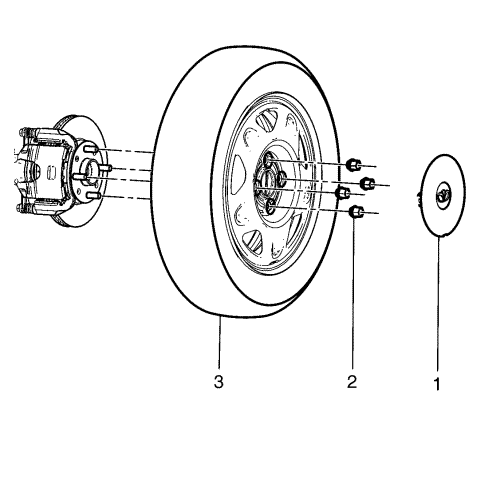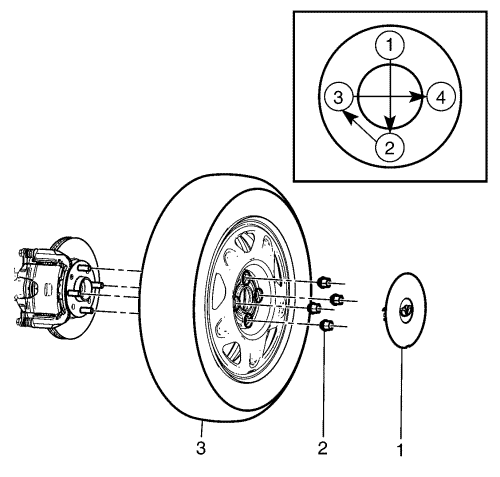Tire and Wheel Removal and Installation
Removal Procedure
Caution: Refer to Lifting and Jacking the Vehicle in the Preface section.

- Raise and support the vehicle.
- Remove the wheel cap (1), if equipped.
- Mark the wheel in relation to the wheel hub flange.
- Remove the wheel nuts (2).
Warning: If penetrating oil gets on the vertical surfaces between the wheel and the rotor or drum it could cause the wheel to work loose as the vehicle is driven, resulting in loss of control and an injury accident.
Caution: Removing the wheel may be difficult because of foreign materials or a tight fit between the wheel and the hub/rotor. Slightly tap the tire side wall with a rubber mallet in order to remove the wheel. Failure to follow these instructions may result in damage to the wheel.
- Remove the tyre and wheel assembly (3) from the vehicle. If the tyre and wheel assembly is difficult to remove, perform the following steps:
| 5.1. | Install and tighten all wheel nuts on the affected wheel. |
| 5.2. | Loosen each wheel nut two turns. |
| 5.3. | Lower the vehicle to the ground. |
| 5.4. | Rock the vehicle from side to side. |
Caution: Refer to Lifting and Jacking the Vehicle in the Preface section.
| 5.5. | Raise and support the vehicle. |
| 5.6. | Remove the wheel nuts. |
| 5.7. | Remove the tire and wheel assembly. |
Installation Procedure
Warning: Before installing the wheels, remove any buildup of corrosion on the wheel mounting surface and brake drum or disc mounting surface by scraping and wire brushing. Installing wheels with poor metal-to-metal contact at the mounting surfaces can cause wheel nuts to loosen. This can cause a wheel to come off when the vehicle is moving, causing loss of control and possibly personal injury.
Note: Wheel nuts, studs, and mounting surfaces must be clean and dry.
- Remove any corrosion or foreign material from the wheel and the hub mounting surfaces.
- Clean the threads on the wheel studs and wheel nuts.

- Install the tyre and wheel assembly (3). Align the locating mark of the wheel to the hub.
Caution: Refer to Fastener Caution in the Preface section.
Note: Tighten the nuts evenly and alternatively in the sequence shown, in order to avoid excessive runout.
- Install the wheel nuts (2) and tighten in sequence shown to 120 N·m (89 lb ft).
- Install the wheel cap (1), if equipped.
- Lower the vehicle to the ground.
| © Copyright Chevrolet. All rights reserved |

